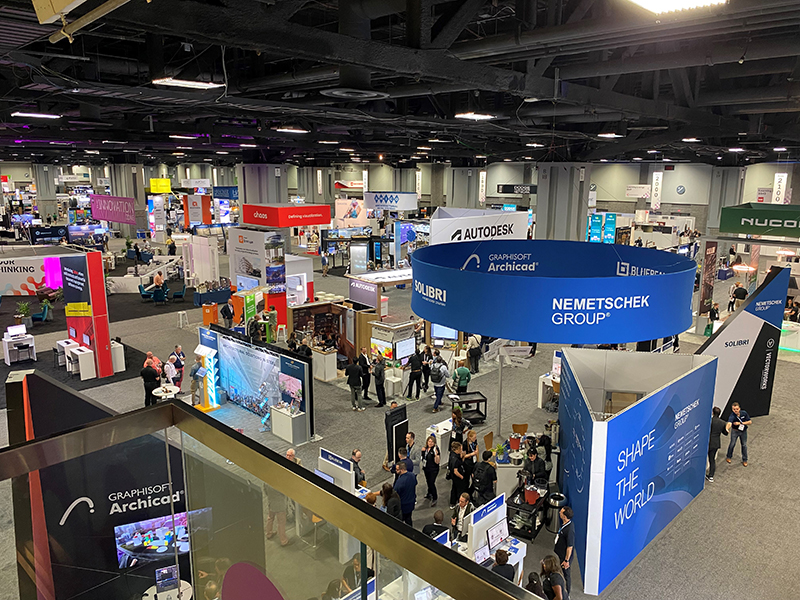Security, size and sustainability drive product development, say AIA exhibitors

The AIA24 Conference of Architecture & Design, organized by the American Institute of Architects, welcomed nearly 550 building product manufacturers to its Expo, held June 6-7 in Washington, D.C. Glass and fenestration industry solutions on the show floor demonstrated an increased interest in size, sustainability and security from the architectural community.
Here are a few takeaways from the show:
Exhibitors showcase systems with security and size
Exhibitors showcased a range of products related to safety and security, from ballistic-rated solutions, storm impact systems, fire-rated glazing and more.
Wade Arnold, director of commercial sales, U.S. Bullet Proofing and Quikserv, says the company’s booth visitors were especially interested in security solutions for the surrounding D.C. area, given the amount of security building products needed for high-security building. Show visitors, including architects, showed interest in multifunctional security solutions, for example, ballistic-rated systems that are also bird-friendly, he says.
Mark Suehiro, technical director, architectural hardware, C.R. Laurence, says he’s seeing “a big demand for panic hardware” and that “security is huge” right now for building products. In terms of size, he says that large companies like Apple are helping to push demand for larger glass sizes with big projects that include huge spans of glass.
Glass and system sizes will continue to increase, according to a plurality of AIA exhibitors. McGrory Glass showcased a 14-foot-tall, butt-glazed, fire-resistant glass system. Though big glass sizes have lagged behind European and Asian markets, sizes are still increasing says McGrory’s rep. Part of the impetus to have bigger-size glass, and thus a larger system, is to ensure sightlines and views while maintaining the “minimalist” framing look, even for more complex glazing. “People want more elegant solutions,” he says.
Safti First’s Tim Nass, vice president of national sales, says he’s also seeing more interest in not just STC-rated solutions, but also OITC, Outdoor/Indoor Transmission Class, for external glazing to reduce noise from the outside.
A plurality of exhibitors also agree that codes will push greater security glazing adoption. GlasPro showcased its ClearShade insulating glass unit insert, a honeycomb pattern that can be used to regulate solar heat gain coefficient and visible light transmission, while also providing opportunities for privacy and security by minimizing views of buildings or rooms from the outside. While the product has been installed in recent school projects, ClearShade rep Ryan Tobin says, “until building codes require [security solutions] it’s difficult to specify.”
Becoming a consultant to the architectural community
Architects remain focused on sustainability, says Kawneer’s Sneh Kumar, director of global sustainability, but given the diversity of standards governing energy efficiency, circularity and green building, it still falls on industry members to educate architects on what glazing systems can do. Kumar has been educating architects about aluminum standards, including low-carbon aluminum produced using hydroelectric energy. The company encouraged an architect on a recent project to go beyond the written language of one standard, which required that 50% of aluminum used for building be recycled—Kumar pointed out that if the other 50% of aluminum used is produced using an energy source with high carbon emissions, the emissions-savings is effectively canceled out. In this instance, Kawneer encouraged the use of low-carbon, hydroelectric-produced aluminum in order to effectively reduce embodied carbon for the project.
Exhibitors also emphasize how important it is to continually educate architects about glass and fenestration products to ensure they are used, and used correctly, in the built environment. Action Bullet Resistant’s Robert Faber, sales and marketing specialist, says the company’s framed, bullet-resistant systems can sometimes be spec’d incorrectly. The company works to prevent this by offering lunch and learns to the architectural community.
Frameless Hardware Co.’s Patrick Comeford, pre-bid services, emphasizes the need to be proactive about education architects in a “spec advisory capacity.” The company works to be proactive in reaching out to architects and making the relationship with architects a “consultative” one, he says.
